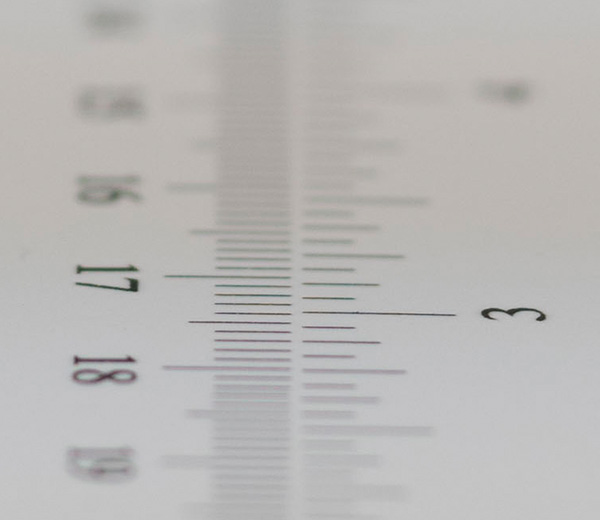|
Sony FE 90mm f/2.8 G OSS macro ( SEL90M28G ) - APS-C Format Lab Review - Analysis |
|
Lens Reviews -
Sony Alpha/NEX (APS-C)
|
|
Page 2 of 2

Distortion
Interestingly the Sony lens behaves a bit differently than in the full format scope - there are barely any detectable distortions. Seems as if most the (slight) distortions are ramping up outside of the APS-C image field.
Vignetting
The Sony lens enjoys the usual sweet spot advantage when used on APS-C format cameras. The light falloff is reduced to just over 0.6EV (f-stops) at fully open aperture.
The vignetting is negligible from f/4 onward already.

MTF (resolution)
The Sony lens is capable of delivering superb results straight from the max. aperture. The center performance is already outstanding at f/2.8 and the quality of the outer image region is easily very good. The peak performance is reached between f/4-8 with an excellent performance across the whole image frame - it doesn't really get any better than this. This is actually quite amazing on such a dense 24 megapixel sensor. Diffraction effects have a higher impact from about f/11. The quality is still good at f/16 whereas f/22 should be avoided for obvious reasons (as usual).
The centering quality of the tested sample was very good. Field curvature is not an issue.
Please note that the MTF results are not directly comparable across the different systems!
Below is a simplified summary of the formal findings. The chart shows line widths per picture height (LW/PH) which can be taken as a measure for sharpness.
If you want to know more about the MTF50 figures you may check out the corresponding Imatest Explanations
Chromatic Aberrations (CAs)
The Sony lens produces extremely low amount of lateral CA (color shadows at harsh contrast transitions) with an average CA pixel width around the 0.4px mark. Truly impressive.

Bokeh
Sony emphasizes that their G (and more so their GM) lenses offer an outstanding bokeh ... but then who's still believing marketeers these days really ...? Well, while there is a grain of truth in this statement, things aren't absolutely perfect.
Out-of-focus highlights have a circular shape between f/2.8 and f/5.6. However, the inner zone of the highlight discs is nervous at least in bright discs. There's a bit of an outlining effect which is getting obvious from f/5.6 onward. In the full format scope we observed "cat's eyes" (deteriorated discs) near the image corners. Due to the APS-C crop, this is a much lesser issue here, of course.
 On the positive side, the rendition of the focus transition zone is very smooth and buttery in both the image background, slightly less so in the image foreground.
On the positive side, the rendition of the focus transition zone is very smooth and buttery in both the image background, slightly less so in the image foreground.

Bokeh Fringing / Longitudinal Chromatic Aberrations (LoCA)
So-called bokeh fringing is an effect that occurs around the focus point (on the Z-axis). It's visible as halos of different colors in out-of-focus areas - magenta (red + blue) in front of the focus point and green beyond.
The Sony FE 90mm f/2.8 G OSS macro is moderately fast so it's not overly affected by the issue. You can spot traces of this at f/2.8 but this is rather negligible.
If you traverse through the aperture range below, you will also recognize that the focus remains static (thus no residual spherical aberrations).
Note: Sorry about the banding in these images. The samples were taken with electronic shutter and the banding is an effect from the artificial light in this case.
|
Move the mouse cursor over the f-stop marks below to observe the respective LoCAs
|
| f/2.8 |
f/4 |
f/5.6 |
|

|
Verdict
The Sony FE 90mm f/2.8 G OSS macro performed great on the Sony A7R II already so it doesn't come as a surprise that it is even a bit better on an 24mp APS-C camera. In terms of sharpness the Sony lens is already impressive at f/2.8 and tack sharp across the image frame in the f/4-f/8 range . Lateral CAs are generally a non-issue. The vignetting figures are low with just minor traces at f/2.8. The image distortions are irrelevant. On the downside we are not so much convinced of the way the lens is rendering out-of-focus highlights. The general quality of out-of-focus blur is very good if not excellent though. The amount of bokeh fringing is negligible.
On the mechanical side, it doesn't feel quite as rock solid as say the Zeiss FE 55mm f/1.8 OSS or the Sony FE 70-200mm f/4 G OSS. However, we admit that this is mostly subjective. The lens barrel feels a bit hollow but formally there's nothing wrong with the construction. We certainly appreciate the weather sealing. The precision of manual focusing could be a bit better especially considering the fact that the lens is relying on the focus-by-wire approach. The AF is quite fast although not on the level of comparable Canon/Nikkor DSLR lenses.
Of course, our "highly recommended" mark remains intact in the APS-C scope. Sony is on quite a run really. Both Canon and Nikon should be scared by now ...
|